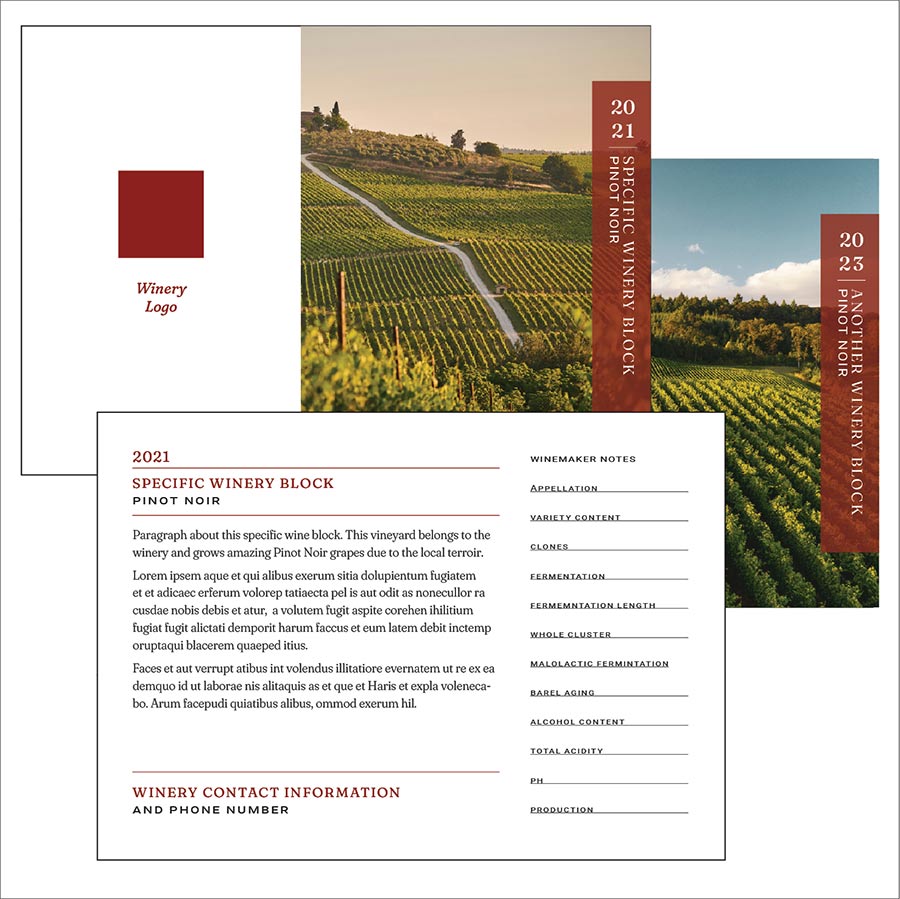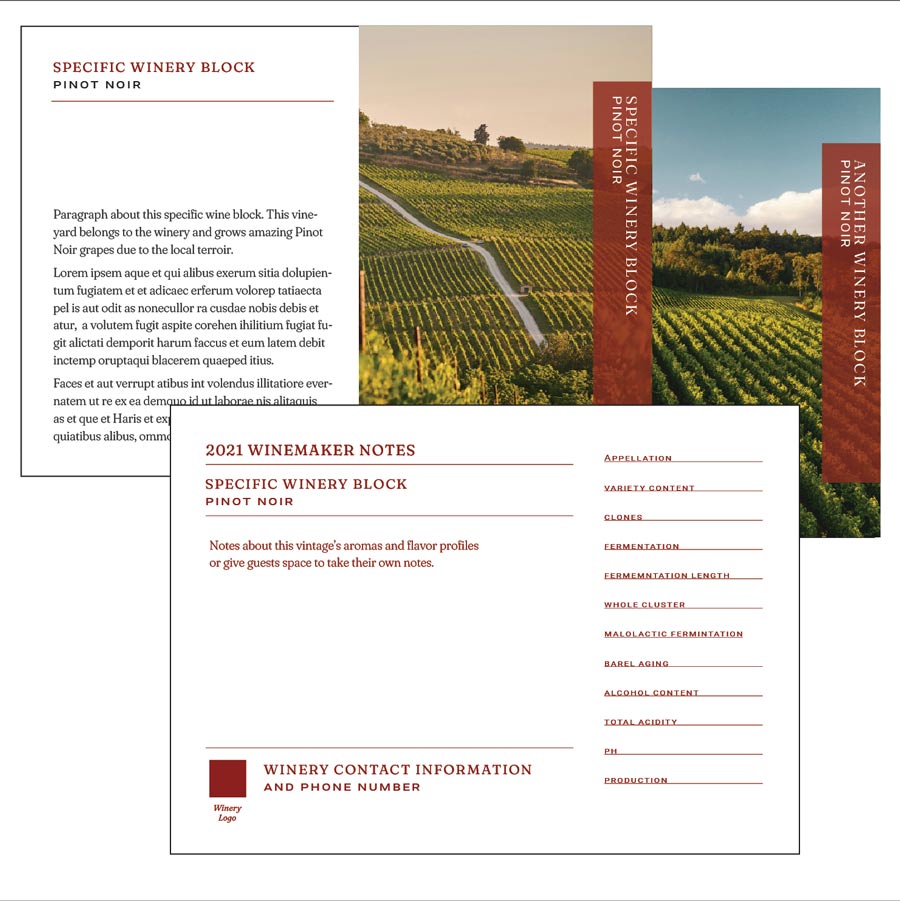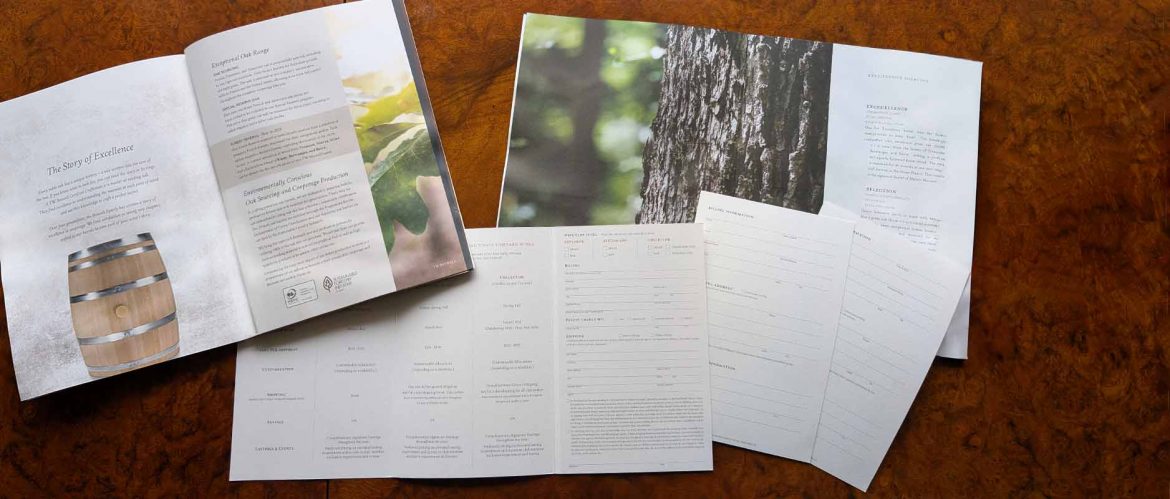As a graphic designer with foundations in print marketing, I’ve worked with a range of businesses, especially wineries and wine clubs. One thing I’ve noticed: consumers genuinely appreciate finding beautifully designed marketing collateral and educational materials in their wine club shipments. Not only do these materials elevate your brand’s sophistication, but they also create a memorable, high-class experience for your customers.
That said, creating high-quality print collateral can be expensive. For small businesses and boutique wineries, managing costs while maintaining a premium feel is essential. Here are 9 smart ways to reduce print marketing costs without sacrificing the elegance and sophistication that your brand deserves. And while this list is tailored to wineries, it can apply to any small business collateral as well.
1. Embrace Concise Messaging
When it comes to print marketing, less truly is more. Instead of cluttering your materials with long blocks of text, focus on succinct, impactful messaging. Let high-quality visuals, photography, and infographics tell your brand’s story. Not only will this create a more engaging experience for your customers, but using less ink and fewer pages can also cut down printing costs.
Pro Tip: Printers often offer discounts for designs with low ink coverage, so minimalistic designs with plenty of white space can help save money without compromising on style.
2. Avoid Full-Bleed Designs
Designing without bleeds (where the ink extends to the edge of the paper) can significantly lower costs. By sticking to traditional margins, printers can fit more pieces onto standard stock sizes, minimizing paper waste. If your design doesn’t need to bleed, let your printer know—you might be able to negotiate a lower rate.
3. Hire an Experienced Print Designer
One of the most common mistakes businesses make is hiring inexperienced designers who are unfamiliar with the intricacies of print production. Files created in RGB color mode or designed using platforms like Canva are often unsuitable for professional printing and can lead to costly corrections.
An experienced print designer (like myself!) will:
- Ensure files are set up in CMYK for accurate color reproduction.
- Prepare files with proper margins, bleeds, crop marks, and print-ready formatting.
- Design pieces with correct folds—understanding, for example, that in a trifold brochure, the panels are not all the same size but it’s a different story for accordion folds.
- Avoid placing large ink coverage over folds to prevent cracking.
- Avoid large color images on specialty papers, like pearl or textured finishes.
- Help minimize unnecessary expenses like pre-press corrections or color adjustments.
4. Design with Fewer Colors
A skilled designer can create visually stunning marketing pieces using fewer than four colors. For instance, consider using full color on one side and black-only on the other. Your printer will call this “4 over K.” Alternatively, use just black and a spot color on both sides while use shading techniques and white space to give the illusion of 4 or 5 colors being used.
Real World Example:
A winery near me used to hand out winemaker’s notes on rack cards in their formal tasting room. Customers loved the cards and although they may have led to a higher rate of conversion to the Wine Club, it was ultimately decided these were too expensive to print and were discontinued. However, several techniques could have been employed to decrease print costs and reach a middle ground so the winery wouldn’t need to forgo these completely. I recreated a sample of the cards below.
The original cards had vintage specifics on both sides which required reprinting every version, every year.

To save print costs, my recommendation would be to bulk print the front of each version of the card with just information that does not change. An image of the vineyard and it’s description would make the color side of the cards universal and could be printed en masse. Only the back of the cards would need printing with the specific winemaker’s notes in one color year after year. Thus, giving the winery the ability to have customization but get the benefit of bulk pricing.

5. Choose Cost-Effective Paper Stocks
While premium paper stocks offer a luxurious feel, they’re also pricier. Opt for more affordable options unless the piece truly demands a high-end material. Recycled paper stocks are often cheaper and appeal to eco-conscious consumers, making them a win-win for wineries and wine clubs.
Pro Tip: Talk to your printer about the most economical paper options that still offer a professional look.
6. Limit Special Finishes
Special finishes like embossing, foil stamping, or spot UV coatings add elegance but can quickly inflate costs. Instead, reserve these premium touches for high-impact materials like flagship brochures or event invitations. For routine print collateral, a clean, minimalist design will be both cost-effective and classy.
7. Maximize Press Sheets with Imposition
Instead of printing small batches over time, talk to your printer about how to maximize the use of each press sheet through a strategy called imposition. For example, instead of printing a few hundred Chardonnay tasting notes now and thousands of Pinot Noir notes two weeks later, print all your materials at the same time. Your printer can fit different designs on the same press sheet, reducing costs by optimizing the press run.
Being flexible with quantities and providing all your artwork upfront will help your printer reduce setup time and save you money in the long run.
8. Stick to Standard Sizes
Custom-sized print materials often require additional cutting and setup costs. Designing within standard dimensions allows printers to utilize materials more efficiently, saving time and reducing paper waste.
For example:
- Use standard postcard sizes for direct mail.
- Stick to conventional brochure dimensions.
- Avoid custom shapes that require die-cutting, unless they’re essential to your branding.
9. Plan Ahead and Proof Thoroughly
Last-minute changes or errors discovered after printing can be extremely costly. Ensure you:
- Thoroughly proofread all text.
- Check color profiles, image resolution, and layout alignment.
- Create prototypes or mock-ups to catch any potential issues before sending them to print.
Final Thoughts:
By applying these strategies, wineries, wine clubs, and small businesses alike can save money on their print marketing efforts without sacrificing quality. Thoughtful design, strategic planning, and working with professionals familiar with print processes will help your brand make a high-end impression while staying within budget.
Looking for a cost-effective, sophisticated design solution for your next wine marketing campaign? Contact me today to discuss how I can help bring your brand to life with beautifully crafted print materials.

